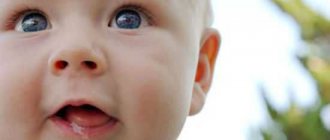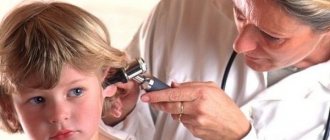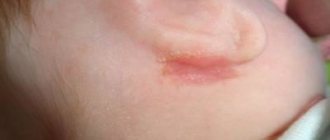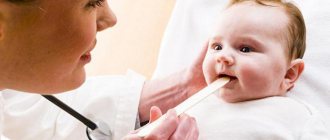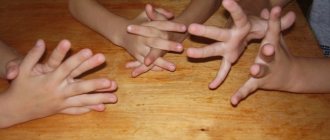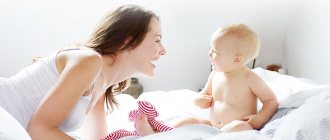Natural causes
Why does the baby have a bald spot on the back of his head? Many parents ask their pediatrician this question. If a baby has slight baldness, this is most often not a sign of pathology.
During the formation of the fetus in the womb, the baby's hair follicles promote the growth of lanugo-vellus hair, which is thin and soft rods. After the baby is born, this hair continues to grow for some time.
Around the age of 3-6 months, new rods form in the dermal layer of the baby’s scalp from the papilla, which is the basis for the growth of any hair. They push out the vellus hairs, as a result of which they separate from the dermal papilla and come out. This leads to the formation of a bald spot.
Causes of child hair loss
- When the baby was in the mother's body, he received a very large amount of hormones. Later, after birth, this stopped and the child no longer feeds from his mother, he began to adapt to the environment. Due to this, hair growth slows down.
- The hair of newborns is very soft and fragile, it does not feel the same as that of adults. You are probably familiar with the term “fluff in newborns.” Hair does not become coarse immediately, but after some time, from six months to one and a half months.
Baby fluff breaks very well, rolls up and breaks out. From the previous point we know that hair growth is slowed down due to the adaptation of the child’s body. So it seems that the child is going bald.
- Hair can be wiped off when the baby is walking in a hat. Friction occurs plus the child sweats, this contributes to hair loss in the baby.
- Rickets. This is exactly what you should be wary of, because one of the symptoms of rickets is hair loss.
Rickets is very easy to distinguish from ordinary prolapse, because the symptoms are as follows:
- The skin may be marbled in color;
- Hair falls out randomly, while usually newborns simply develop a bald patch at the back of the head;
- Increased body temperature;
- The child sweats profusely;
- Large sunken fontanel;
- The baby began to eat poorly;
- The child is very nervous, fearful and restless.
So, if you find several other symptoms in your child in addition to baldness, then you need to consult a doctor for advice.
There are also a number of reasons that are not associated with either physiology or rickets. The causes of partial hair loss may be:
- Avitaminosis;
- Stress;
- The baby is not eating properly;
- Metabolism is disrupted.
Why is this phenomenon observed at the back of the head?
Regarding why a bald spot on the back of a baby’s head appears precisely on the back of the head, everything is simple. Until the baby learns to crawl and sit, he spends all his time in the crib. There he lies on his back and turns his head in different directions, which accelerates the process of vellus hair loss on the back of his head.
And when does the bald spot on the back of a baby’s head grow over? When the intensity of the child's movements increases, the back of the head will begin to grow hair again.
Typically, such processes occur gradually, and parents do not even notice the problem. If you experience excessively rapid hair loss, you should consult a doctor.
Why does a newborn's hair fall out on the top of the head?
If fungal skin does not occur so often, the baby’s labile nervous system reacts sharply to changes in temperature and excitement. This causes excessive sweating and loss of hair in the parietal region. By maintaining the same room thermometer readings within + 20°C, the problem can be avoided.
Other causes of baldness:
- secondary diseases of the nervous and cardiac systems, malfunctions of the endocrine glands;
- infectious pathologies;
- deficiency of vitamins A, D, C;
- dystrophy;
- abnormalities in the structure of the hair shafts.
Presence of pathologies
The cause of baldness on the back of a baby's head can also be pathological processes in the body. If the intensity of this process is quite high, then this may indicate the presence of a number of diseases:
- Childhood rickets. This is the most common reason for the formation of bald spots. The presence of the disease is indicated by the presence of additional symptoms. Thus, excessive irritability, tearfulness, sleep problems, and high sweat production appear. There are several reasons for the appearance of this pathology. This may be a lack of vitamin D in the newborn’s body, premature labor, problems with the functioning of the endocrine and enzyme systems, or poor nutrition. The risk group includes children under three months of age.
- Gneiss is a disease characterized by the formation of a bald patch on the baby’s scalp, in place of which a dense crust forms. The reasons for its formation may be hormonal imbalance or an allergic reaction, which lead to increased sebum secretion. In order not to worsen the baby’s condition and prevent the appearance of scars, it is strictly forbidden to remove the crust yourself.
Other reasons
There are other causes of baldness on the head of a baby. This could be ringworm, which is one of the fungal and viral diseases. In addition to the formation of a bald spot on the back of the head, the following symptoms may occur:
- redness;
- inflammation;
- peeling;
- itching;
- hair breaking.
This type of disease is considered highly contagious, and you can catch it at the slightest contact with a sick person.
Also, one of the reasons may be a deficiency of nutritional components. If there is a lack of vitamins and minerals, pathology develops. But in this case, hair loss is typical in other areas of the head.
What is telogen effluvium in infants?
Uniform loss of vegetation provokes abnormal disturbances in the cycles of dormancy and growth. The problem occurs:
- against the background of drug therapy;
- with excessive intake of retinoids, anticonvulsants and antiviral drugs;
- connective tissue pathologies;
- erythroderma;
- stress load;
- malabsorption - impaired absorption of nutrients;
- with enteropathic acrodermatitis;
- genetic abnormalities.
Diffuse hair loss in an infant
Who to contact?
When a bald spot appears on a baby’s head, you need to stop panicking and think about which doctor is best to take your baby to. If the loss develops rapidly, but there are no signs of illness on the skin, it is recommended to go to see a pediatrician.
When an inflammatory process is observed, red spots are present, there is a crust and the skin is peeling, you should visit a dermatologist.
Quite often, doctors are not particularly attentive to children's bald patches, since they recognize them as a natural physiological phenomenon. Therefore, if the mother is still worried about the child’s condition even after consulting a pediatrician or dermatologist, it is worth visiting a trichologist. This is a hair specialist. He will immediately diagnose their condition and the newborn’s skin, and then draw the appropriate conclusions.
Prevention of diseases
Knowing that before the age of six months a baby is susceptible to various diseases, including those that cause the appearance of a bald spot on the back of a baby’s head, it is necessary to perform certain preventive manipulations:
- If the child has already begun to be fed, then it is necessary to use products such as green vegetables, nuts, legumes, and it is very important to monitor the quality of drinking water.
- On sunny days, you should walk with your child as much as possible, this helps increase vitamin D in the blood and improves the functioning of the immune system.
- Hygiene rules must be strictly observed. Once a week, the baby's head should be washed with a special shampoo for newborns. On other days, hair is rinsed with warm, clean water. In addition, the child must have his own towel.
- During the washing process, you can apply special baby hair oil to your baby’s head. It is applied for 5 minutes and then washed off with shampoo.
- Particular attention should be paid to the emotional state of the child, because the appearance of a bald spot on the back of the head at this age can also be caused by nervous overstrain.
How to prevent baldness
The most important thing is to stop panicking. The baby senses the parents’ mood, and all emotions are quickly transmitted to him. If there are no other signs of hair loss, such as redness and inflammation, then simply visit your pediatrician and get his advice. If other phenomena are observed, you should consult a dermatologist.
To avoid the occurrence of diseases that were discussed above, it is enough to adhere to a few obvious rules:
- Make sure your child receives balanced, vitamin-rich foods.
- Don't neglect a walk on a nice sunny day. The baby's skin should receive enough vitamin D. Walking will strengthen him and improve the functioning of his immune system.
- Maintain good hygiene. Do not overuse frequent hair washing. Once a week, it is enough to use a hair product designed specifically for your age; on other days, simply rinse your hair with water. Get your baby his own towel.
- You can use hair oil, it should be kept for about five minutes and then washed off with baby shampoo.
Even if your child does not suffer from baldness and does not have problems with hair growth, you should not neglect simple rules for caring for them.
Choose the right products to support your child’s hygiene and help strengthen their hair. Give your baby a head massage, it will help strengthen the hair follicles.
Remember: if baldness is a physiological feature, then it will disappear by 6 months. If the problem persists, a qualified doctor will help you find a solution and prescribe adequate treatment.
Treatment
If it has been determined that the bald spot on the back of the head in an infant is caused by a disease such as rickets (the most common cause), then the therapy should be comprehensive. It includes techniques aimed at eliminating the factors that provoked the development of this condition.
Treatment of rickets is carried out under the strict supervision of a pediatrician and includes specific and nonspecific methods of therapy. In the second case, treatment is aimed at strengthening the general condition of the body and includes:
- proper organization of the daily routine;
- sufficient exposure of the baby to fresh air;
- nutrition that helps normalize metabolic processes in the body;
- regular exercise and massage.
During the day, children should be in the fresh air for at least 2-3 hours, with the exception of severe frosts. In the summer, the baby should be hidden from exposure to direct sunlight. Walking in the shade of trees will allow the body to produce enough vitamin D.
Classical therapy methods
The conclusion is made after differential diagnosis excluding seborrheic dermatitis, psoriasis or ringworm. Treatment is carried out for several months according to an individual regimen including:
- biogenic stimulants (vitreous humor);
- nootropic drugs;
- in difficult cases, disprospan with prolonged action is prescribed.
Medicines from these groups improve metabolic processes and correct hormonal balance.
Local therapy
Special gels and suspensions are applied to the affected areas under an occlusive dressing at night (tight-fitting cap), tonics - naphthalan alcohol, silocast.
Regardless of the type of alopecia, physiotherapy procedures are useful - massage, electrophoresis, galvanization. After treating the lesions with photosensitizing drugs, ultraviolet irradiation is carried out.
Sometimes doctors advise not to rush into treatment and wait a few months, but this is only possible in the absence of concomitant skin diseases.
Diagnosis for alopecia
Preventative care
There is no need to wash your baby's hair often. Decoctions of chamomile, string, and calendula are added to the water. To carry out a hygienic procedure, baby shampoos can be used after 5 months. During the postpartum period, baby soap with a mild formula is used. After the procedure, the strands are soaked with a towel and combed with a sparse comb with rounded teeth. Although there is no universal therapy, timely care for the child will help avoid many problems.
Also on our website you can read an article about the causes of hair loss in 3-year-old children.
READ ALSO: What diseases do lice carry?
Specific techniques
When treating rickets, medications containing vitamin D, phosphorus, and calcium are mandatory. This is a specific treatment method.
The amount of drugs used per day is determined only by the pediatrician, taking into account the age and weight of the baby, as well as the severity of the pathology. When calculating the dosage, attention is paid to the presence of concomitant symptoms, namely anemia or the presence of diseases of the internal organs.
It is recommended to refrain from using an alcohol solution of vitamin D, since it contains too much of the vitamin, which can cause an overdose in the baby. Fish oil will also not be the best solution if you have rickets, since it has a specific smell and taste, which can cause a negative reaction in a fragile body.
If you notice a bald spot on the back of a child’s head, you should not be nervous, but observe the changes for several days. If hair loss is severe, then you need to consult a doctor and not self-medicate.
Causes of baldness in infants
Parents of babies whose scalp hair is rubbing dream of getting rid of this problem. The causes of alopecia are physiological and pathological.
Bad genetics
Newborn sneezes often - what to do
Genetic factors play a role in a child's hair growth. If mom and dad have thick, lush, beautiful hair, then the likelihood of alopecia in the baby is minimal. If one of the parents has a problem, the chance of bald spots on the child’s head increases.
A genetic problem cannot be solved. This trait is hardwired into the DNA. You can try to stimulate hair growth with frequent haircuts, but this does not always help.
Lack of vitamins
Nutrition for your baby is important for the development of the whole body, including hair. A newborn receives a large amount of vitamins and minerals through mother's milk or formula. Due to this, the follicles receive nutrition.
Sometimes breast milk does not contain enough nutrients. This occurs due to improper nutrition of the mother during breastfeeding. Also, milk production in the mother’s body may be disrupted, making it insufficiently nutritious.
Important! If parents notice signs of baldness, first of all they should pay attention to the baby’s nutrition.
Erasing when turning head
Newborns and infants are recommended to sleep on their side. The head should be turned to the side. This is necessary so that the baby does not choke on vomit during an unexpected regurgitation. After each night feeding, the baby is transferred to the other side.
By the second month of development, the child begins to roll over independently. He does this slowly and often rubs his head on the blanket. Due to this, the hairs on the back of the head and temples are erased.
The baby is being combed
Hormonal changes
Hair loss is characteristic of thyroid diseases. Hypothyroidism has this symptom. The disease can be determined by taking a hormone test. This will require venous blood. Children experience blood sampling quite painfully.
The disease can be congenital or acquired. Hormonal levels do not depend on the type of nutrition. The disease develops due to a lack or excess of iodine.
Telogen effluvium baby hair loss
The hair on the baby's head falls out gradually, and there are no areas of alopecia. The thickness of the cover is disturbed. Areas of baldness increase in the temple and back of the head areas. Sometimes the disease is localized on the front of the head.
Hair shaft injuries
Brittle hair stems occur with autoimmune diseases in a child. The hairs simply break off and cannot grow to their normal length. The child’s body produces specific antibodies that are aimed at destroying hair follicles and shafts. The baby is subjected to special treatment.
This also happens on a physiological level. Infants go bald due to constant friction of the head against the surface of the crib. Bald spots appear mainly on the back and sides of the head. Alopecia resolves on its own with age.
Fungal and nerve damage to hair
Children often become infected with fungal diseases. It is called trichophytosis. The incubation period lasts up to 7 days. Children become infected through contact. For example, they shared the same comb with an infected baby or put on someone else’s hat. Lesions are observed on the scalp; they have clear contours. Hair in this area breaks off at the base of the root and at a height of 3 cm.
The baby is held under the armpits
Ringworm
Ringworm is caused by a fungus. It affects not only the hair, but also the top layer of the skin. Infection occurs through contact with infected people and animals. It is transmitted by contact.
Hair begins to break off and fall out. At the site of the outbreak, a pink, rounded lesion is formed, which is covered with small leathery scales. You need to immediately consult a doctor and undergo a course of treatment, as the baby may remain completely bald.
Alopecia areata
The second name of the disease is alopecia areata. It often occurs in children and is usually diagnosed after 5 years of age. Until this age, doctors monitor the intensity and degree of hair growth. But this does not mean that there is no need to sound the alarm if the baby begins to go bald earlier. It is worth consulting a doctor in any case and discussing diagnosis and treatment methods with him.
The disease manifests itself gradually. First, small bald spots appear on the occipital and temporal parts of the head. Gradually they increase in size and begin to merge into one large lesion. The hair becomes brittle and is thicker at the root than at the ends.
Important! Alopecia areata accounts for almost 50% of childhood baldness.
Allergy
Atopic dermatitis occurs on the scalp. This reaction is typical of a new shampoo or a specific component of it. Large pink spots appear on the surface of the skin, they peel and itch. Hair begins to fall out at the site of the lesion, as the top layer of skin is affected. Treatment is carried out with a course of antihistamines, and they also find out where the allergen is located.
Symptom of rickets
One of the signs of rickets is hair loss. A child develops a bald spot on the back of his head. This occurs due to a lack of vitamin D. If the disease is in the initial stage, then when the balance of vitamins is restored, hair growth resumes.
If you suspect rickets, it is advisable to seek medical help as soon as possible. In the later stages, the disease cannot be completely cured.
The baby is examined by a doctor
